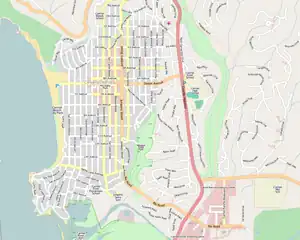| Doud Building | |
|---|---|
| Site of Manzanita Social Club | |
 Doud Building on Ocean Avenue | |
| Location | Ocean Avenue and Mission Street, Carmel-by-the-Sea, California, US |
| Coordinates | 36°33′17″N 121°55′15″W / 36.55472°N 121.92083°W |
| Built | 1932 |
| Built by | Michael J. Murphy |
| Built for | James Cooper Doud |
| Original use | mixed-use retail shop and residence |
| Current use | Retail |
| Architect | Michael J. Murphy |
| Architectural style(s) | Spanish Colonial Revival architecture |
 Doud Building Doud Building | |
The Doud Building, also known as the James Doud Building is a historic commercial building in Carmel-by-the-Sea, California. James Cooper Doud established the building in 1932, built by master builder Michael J. Murphy as a mixed-use retail shop and residence. It is an example of a Spanish Colonial Revival architecture style building. The structure is recognized as an important commercial building in the city's Downtown Conservation District Historic Property Survey, and was nominated and submitted to the California Register of Historical Resources on February 21, 2003.[1]
History

The Doud Building was established for businessman and real estate developer James Cooper Doud and his family, in 1932 as a mixed-use retail shop and residence, located on the southwest corner of Ocean Avenue and Mission Street in Carmel-by-the-Sea, California, opposite the Reardon Building, which it meant to mirror.[1][2]
It is a two-story wood-frame, concrete, stucco Spanish Colonial-style building with the original corner tower. The Reardon Building, directly across Ocean Avenue, has a similar tower. The ground level has a succession of large, fixed pane arcade show windows that were created in a 1970 remodel that cost $15,000 (equivalent to $113,033 in 2022). The upstairs multipaned inset casement windows with original extended wrought iron balconies and railings are accessible by double-pane French doors that lead to an office space that was originally an apartment. Inset Moorish tiles and beveled corners cover the tower that is topped with a hipped Spanish tile roof. A second story insert balcony has a diamond pattern railing. There is a basement retail shop to the rear of the building.[1]
The building qualified for inclusion in the city's Downtown Conservation District Historic Property Survey, and has been nominated and submitted to the California Register of Historical Resources on February 21, 2003. The property is significant under the California Register criterion 1, in the area of history, as a Spanish Colonial Revival commercial building that was built on the site of the Manzanita Club that was the main social gathering place in Carmel from 1916 to 1926. The building was designed and built by master builder Michael J. Murphy in 1932 at a cost of $6,300 (equivalent to $135,127 in 2022). Developer Samuel Finley Brown Morse made use of this style for houses built in Pebble Beach, California, and the style was used in downtown Carmel in the late 1920s and 1930s.[1][2]
The Ocean Avenue property has been the home of many businesses over the years. It was the site of Doctor Becks’s Drug store built by Hugh W. Comstock. The drug store was later demolished, and M. J. Murphy built the Doud Building as an altered Spanish Colonial Revival for commercial shops. Several additions and remodelings took place over the years. The upstairs apartment was converted to an office and studio space after World War II. Local architect Robert R. Jones used the office during the 1950s and 1960s. In 1970, Comstock did a remodel of the former dry cleaners into an Orange Julius corner store for $15,000 (equivalent to $113,033 in 2022).[1]

The building adjacent to the Doud Building was the Spanish-style Carmel Theater designed by A. A. Cantin. It operated from 1936 to 1959 on the southeast corner of Ocean Avenue and Mission Street. The building had arcades with three storefronts, a tower, and a covered balcony. One section of the building is now Tiffany & Co., but the theater was demolished to make room for today's Carmel Plaza.[3]
See also
References
- 1 2 3 4 5 Richard N. Janick (February 21, 2003). "Department Of Parks And Recreation" (PDF). National Park Service. Retrieved June 13, 2022.
- 1 2 Dramov, Alissandra (2019). Historic Buildings of Downtown Carmel-by-the-Sea. Carmel-by-the-Sea, California: Arcadia Publishing. pp. 45, 85, 92. ISBN 9781467103039. Retrieved 2022-06-14.
- ↑ Dramov, Alissandra (2022). Past & Present Carmel-By-The-Sea. Charleston, South Carolina: Arcadia Publishing. pp. 50–51. ISBN 9781467108980. Retrieved 2023-03-08.